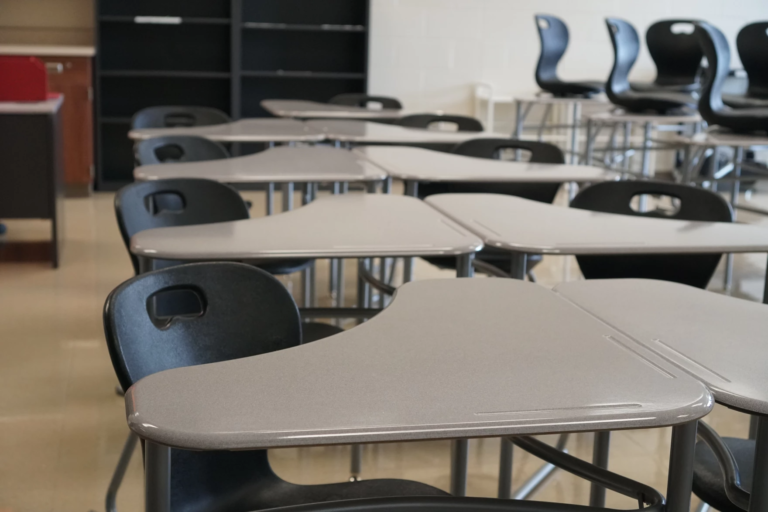ROCKFORD — Around one-third of teachers in the U.S. say they’ve experienced at least one incident of verbal harassment or threat of violence from students during the pandemic. That’s according to a 2022 survey from the American Psychological Association. It’s a big jump from before COVID, when 10% of teachers reported being threatened.
Listen to this story here.
That’s one reason why, late last year, the Illinois legislature’s Public Safety and Violence Prevention Task Force met with educators and school administrators to talk about these challenges.
Some educators from the Illinois Education Association shared testimony of traumatic experiences from the classroom, including this one:
“Last week, a student made threats to a teacher and said he is conducting a survey with other students to figure out which teacher he should kill,” said an anonymous Illinois teacher. “A co-worker reported this incident to the principal and other management at the district. Nothing has been done and the student is back in class.”
The teachers from across Illinois also shared stories about students hitting and throwing chairs at them.
Some educators say the massive disruption of the pandemic is behind the increase in extreme student behaviors. It could be particularly to blame with younger students. They might have been at home for part of preschool or elementary school— crucial developmental years where kids learn so many social-emotional skills.
Mel Gilfillan says that’s what he sees. He’s the president of the Rockford Education Association. He says, when you think of school violence, your mind might automatically picture a big high school student threatening a classmate or teacher. But, that’s not what’s most common.
“We have seen an uptick in some aggressive behaviors, especially from our youngest students,” said Gilfillan.
He says Rockford teachers brought these concerns to the union early in this school year. They followed up with district administration and teachers are still bouncing around solution ideas on district advisory boards.
Solutions are difficult to find, but especially so when it comes to the youngest students.
“You can’t just suspend somebody who’s five and walk them out of the building, because they’ve got to be supervised at all times,” he said.
State Rep. Barbara Hernandez, a Democrat from Aurora, sits on the task force. She says one thing that stuck out to her during the meeting was that schools respond — or not — to these issues in different ways.
“Schools not having a path, a solution or a protocol to certain items; if a student hits a teacher or they get in trouble or there are safety concerns. I feel like there’s not a specific standardized protocol,” said the state representative.
And, like that threat described by the Illinois Education Association, not every teacher gets support from their school to solve these problems.
Unique Morris with IEA says administrators will often tell educators that their hands are tied; there’s nothing they can do to help.
“They will say, because of Senate Bill 100, we are not able to have the consequences, which I know is not true. That’s a misinterpretation of that bill,” she said.
Senate Bill 100 went into effect back in 2016. It told schools to limit exclusionary discipline like suspensions and expulsions. And to only resort to it if they’ve exhausted other interventions and the student’s presence would be a threat to safety or significantly disrupt learning.
But it’s up to schools to decide when a student has stepped over that “significant disruption” line.
Jadine Chou is the chief of safety and security at Chicago Public Schools, who presented to the task force.
She says in a situation where a student is having some kind of crisis episode, their best practice is actually not to remove the student from the classroom, but to remove everyone else. Then have trained behavioral specialists who can de-escalate the situation.
“It’s a little controversial, because what I hear from other parents is ‘Well, why does my child have to suffer? Why is my child disrupted for one kid?” she said. “And I think it’s really just understanding these things on the front end, so we’re going to tell you, ‘this is how it’s going to go so that when it does happen, you’re not surprised.’”
But after that situation, how do schools evaluate how they can help students showing extreme behavior? For one, Chou says, at CPS they look at if that student is on an Individualized Education Plan. If so, are they receiving those services? Are they working with school mental health professionals? Does the school even have social workers on-site?
And if they need more guidance, school districts are now required to have threat assessment teams to help make decisions about whether a student’s presence is disruptive or threatening.
More and more school districts are taking steps to decrease exclusionary discipline. Removing a student from their classroom might work to stop the behavior now, but it may not help get down to the root causes of an issue and prevent it for the long-term.
Many, like Chicago Public Schools, are implementing elements of restorative justice. They say that doesn’t mean no consequences, but rather, hopefully, instructive ones and interventions like trauma-informed therapy.
Rep. Hernandez and the task force will publish a report this year on their findings. She says lawmakers on the task force may file school safety-related bills in the current legislative session as well.

